
Procedural
Requirements
Effective Date: April 15, 2015
Expiration Date: December 31, 2024

|
NASA Procedural Requirements |
NPD 1000.3E Effective Date: April 15, 2015 Expiration Date: December 31, 2024 |
| | TOC | ChangeLog | Preface | Chapter1 | Chapter2 | Chapter3 | Chapter4 | Chapter5 | Chapter6 | Chapter7 | ALL | |
5.1.1 EMPHASIS AND SCOPE. This section identifies overall responsibilities and special relationships applicable to Center Directors at NASA Centers.
5.1.2 OVERALL RESPONSIBILITIES. All Center Directors report to the NASA Associate Administrator and are responsible for providing and/or obtaining resources, overseeing the assignment of workforce and facilities, and managing Center operations to facilitate program and project execution while ensuring that the statutory, regulatory, and fiduciary compliance requirements for the Center are met. The Center Director ensures proper integration, planning, and execution of the programmatic, technical authority, and operational needs of the program and projects assigned to their Center. For resources located at a Center that are managed by the Center, Headquarters, or others, the Center Director is responsible for maintaining, supporting, and/or identifying the workforce and facilities required to meet the planned needs of NASA. The Center Director ensures alignment with the Agency's shared core values of safety, excellence, teamwork, and integrity and provides advocacy for NASA goals and objectives as needed.
5.1.2.1 The key programmatic role of the Center Director is determining how best to execute the various programs and projects at their Center, while balancing resources across Mission Directorate needs in accordance with Agency priorities. The Center Director is the implementing agent of the Agency through partnering with the Mission Directorate Associate Administrators (MDAAs) for successful execution of programs. The Center Director is responsible for communicating any issues to MDAAs and other senior leaders, and participating in strategy discussions as appropriate. Specifically, each Center Director:
a. Allocates resources to support program and project requirements and schedules, to include project management, engineering, and safety and mission assurance. Ensures that human, financial, physical, and other supporting resources are properly applied to programs under their authority, adjudicating priority conflicts where necessary.
b. Facilitates resolution of technical and programmatic issues and risks and ensures regular review and reporting of performance for assigned programs and projects as well as special reviews as appropriate.
c. Provides input for the Agency's and Mission Directorate Program Management Councils reviews on assigned programs and projects.
d. Provides stakeholder input to the MDAAs toward the formulation of future program and project strategy that addresses Mission Directorate goals and objectives.
5.1.2.2 Center Directors are accountable for implementing Technical Authority at their Centers, including the reclama process. Center Directors facilitate the activities of the Technical Authorities and are responsible for ensuring that activities at their Centers are implemented in accordance with accepted standards and applicable NASA policies.
Specifically, each Center Director:
a. Exercises Technical Authority through appropriate institutional delegation.
b. Exercises definitive decision authority as needed to resolve issues on such matters as technical requirements tailoring, waivers, and deviations to requirements.
c. Exercises full and complete decision-making authority to address local execution issues (e.g., weather incidents, active shooter threats, etc.), or other situations involving and ensuring the safety, security and accountability of all NASA personnel working on- or near-site. For this authority, communicates with all personnel working on- or near-site. Informs Agency leadership (including all Officials-in-Charge) of decisions to ensure all impacted personnel are adequately covered.
d. Convenes independent review at major milestones to ascertain technical readiness on assigned programs and projects.
e. Assesses the flight readiness of projects for which he/she is the Technical Authority.
f. Provides for organizational independence of the Technical Authorities and implements the Formal Dissent Process as required in NPD 1000.0, NASA Governance and Strategic Management Handbook, and described further in NPR 7120.5.
5.1.2.3 Center Directors serve a critical role in the operational activities of the Center. Center Directors are responsible for providing and/or identifying requirements for assets, staffing, and facilities required by current programs and projects based on Agency priorities in particular coordination with the Agency functional leaders and the Mission Support Directorate.
Specifically, each Center Director:
a. Executes the Center's implementation of the strategic goals and outcomes in the NASA Strategic Plan, Agency performance goals, and related governance decisions.
b. Provides input for the Agency's Mission Support Council decisions and reviews.
c. Collaborates with other Centers per Section 6.2, Center Roles assignments to accomplish the Agency's objectives.
d. Exercises full and complete decision-making authority to address local execution issues (e.g., weather incidents, active shooter threats, etc.), or other situations involving and ensuring the safety, security and accountability of all NASA personnel working on- or near-site. For this authority, communicates with all personnel working on- or near-site. Informs Agency leadership (including all Officials-in-Charge) of decisions to ensure all impacted personnel are adequately covered.
e. Maintains a safe and healthy workplace environment for the workforce and provides safety, reliability, and quality assurance for all Center activities. Per NPD 8700.1, NASA Policy for Safety and Mission Success, the Center Director also has full authority to stop any unsafe activity; programmatic or otherwise, if it involves Center personnel or Center-owned facilities or assets.
5.1.2.4 Center Directors serve an important role in the stewardship of capabilities located at their Centers for future Agency mission and program needs, in alignment with Agency direction per Section 6.2, Center Roles.
Specifically, each Center Director:
a. Works with Mission Directorates, the Mission Support Directorate, Agency Capability Leadership Teams, and overall Agency leadership to determine Center workforce and facility capabilities required for future NASA missions and programs, including identifying gaps, duplication, and areas to de-emphasize or discontinue.
b. Develops plans for appropriate workforce training, development, allocation, and funding, to include plans to address future gaps in capabilities.
c. Implements approved strategic workforce plans and facilities refurbishment, construction, and demolition necessary to steward the capabilities aligned with Center assignments.
d. Develops integrated capability strategy for the overall Center, such as facility plans and strategic workforce plans.
e. Considers, develops, coordinates, and implements acquisition strategies, including public-private partnerships, to best utilize capabilities.
5.1.2.5 Center Directors serve a key role in both internal and external communications regarding the Agency's current missions, initiatives, and future plans and their Center's roles in those. Specifically, each Center Director:
a. Coordinates and personally participates in the Center's outreach activities, stakeholder management, and partnerships and communicates with NASA Headquarters, on a regular basis.
b. Represents NASA in promoting and maintaining strong community and legislative relations and providing for the widest practical and appropriate dissemination of information concerning all NASA activities.
c. Communicates internally on the Center's and the Agency's initiatives and priorities.
d. Provides executive support and presence at Center workforce, facility, and mission events and milestones.
5.1.3 SPECIAL RELATIONSHIPS.
5.1.3.1 The Center Directors serve as members of NASA's Agency Governance Councils as defined in Chapter 3 of this NPD.
5.1.3.2 The Center Directors participate in other subordinate governance bodies as defined in their charters.
5.1.3.3 The Center Directors support Agency performance and risk management by participating in the Baseline Performance Review.
5.2.1 EMPHASIS. The Ames Research Center (ARC) enables exploration through selected developments, innovative technologies, and interdisciplinary scientific discovery. ARC provides leadership in astrobiology; small-satellites; technologies for crew exploration vehicles; high-end computing; intelligent/adaptive systems; advanced thermal protection; and airborne astronomy. ARC develops tools for a safer, more efficient national airspace and unique partnerships benefiting NASA's mission.
5.2.2 ARC SPECIFIC RESPONSIBILITIES.
Specifically, the Center Director:
a. Implements responsibilities as stated in 5.1, Roles and Responsibilities Common to Center Directors.
b. Executes technical and programmatic Center Roles as designated in Section 6.2.
5.2.3 SPECIAL RELATIONSHIPS.
a. Oversees NASA's Astrobiology Institute (NAI), the Solar System Exploration Research Virtual Institute (SSERVI), the NASA Aeronautics Research Institute (NARI), and the Mars Climate Modeling Center (MCMC).
b. Hosts the NASA Research Park, a shared-use research, development, and education campus comprising more than 100 on-site partners working on innovation and entrepreneurship.
c. Serves as host to other Federal, military, and civilian organizations, such as the California Air National Guard.
5.2.4 IMMEDIATE LINE OF SUCCESSION. In the following order: Deputy Director; Associate Director, and Associate Director for Research and Technology.
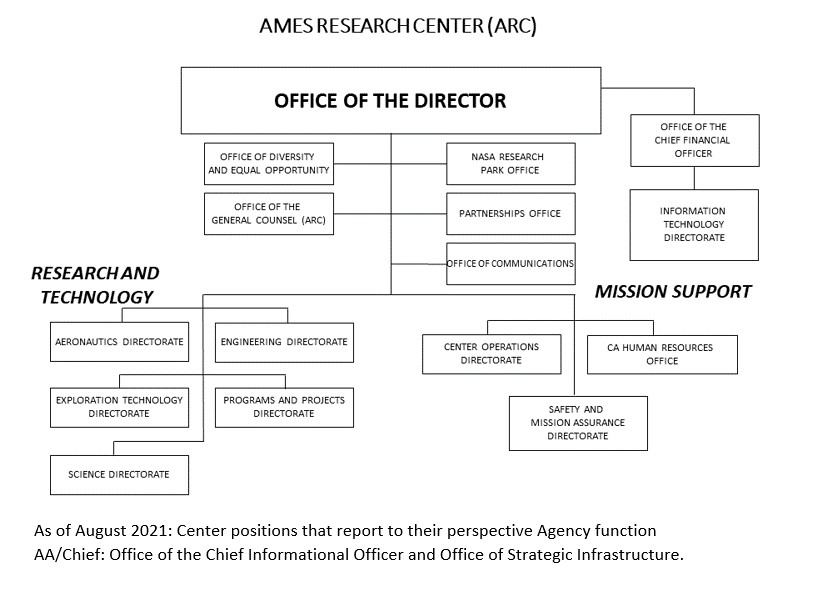
5.3.1 EMPHASIS. The Armstrong Flight Research Center (AFRC) performs flight research and technology integration to advance aviation and aerospace technologies and validates space technology concepts. Using its fleet of aircraft and flight facilities, AFRC conducts airborne science missions with a focus on remote sensing and astrophysics observations.
5.3.2 AFRC SPECIFIC RESPONSIBILITIES.
Specifically, the Center Director:
a. Implements responsibilities as stated in 5.1, Roles and Responsibilities Common to Center Directors.
b. Executes technical and programmatic Center Roles as designated in Section 6.2.
5.3.3 SPECIAL RELATIONSHIPS.
a. Shares an alliance with the U.S. Air Force Production Flight Test Installation (Plant 42) and its two 12,000-foot runways.
5.3.4 IMMEDIATE LINE OF SUCCESSION. In the following order: Deputy Director; Director for Research & Engineering; and Director for Flight Operations.
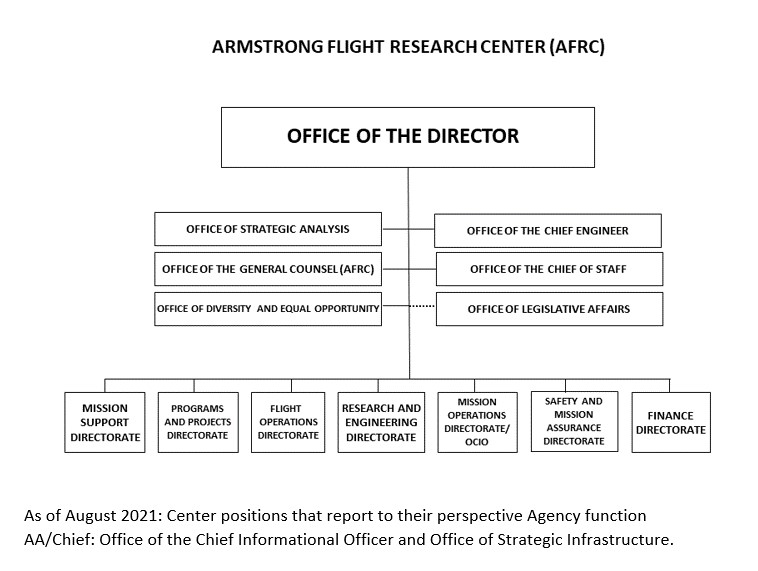
5.4.1 EMPHASIS. The Glenn Research Center (GRC) develops critical space flight systems and technologies to advance the exploration of our solar system and beyond while maintaining leadership in aeronautics. In partnership with U.S. industries, universities, and other government institutions, research and development efforts focus on advancements in air-breathing propulsion, in-space propulsion and cryogenic fluids management, communications technology, and power systems. GRC technology research includes energy storage and power conversion, advanced materials for extreme environments, and physical sciences.
5.4.2 GRC SPECIFIC RESPONSIBILITIES.
Specifically, the Center Director:
a. Implements responsibilities as stated in 5.1, Roles and Responsibilities Common to Center Directors.
b. Executes technical and programmatic Center Roles as designated in Section 6.2.
5.4.3 SPECIAL RELATIONSHIPS.
Manages the following component facility: Neil A. Armstrong Test Facility.
a. The Neil A. Armstrong Test Facility is an off-site complex of test facilities used to perform complex ground tests for the international space community.
b. Hosts the NASA Safety Center (NSC) in close proximity to GRC. As an Agency technical and service support center, the NSC supports the Safety and Mission Assurance requirements of NASA's portfolio of programs and projects.
5.4.4 IMMEDIATE LINE OF SUCCESSION. In the following order: Deputy Director; Associate Director; and Director of Research and Engineering.
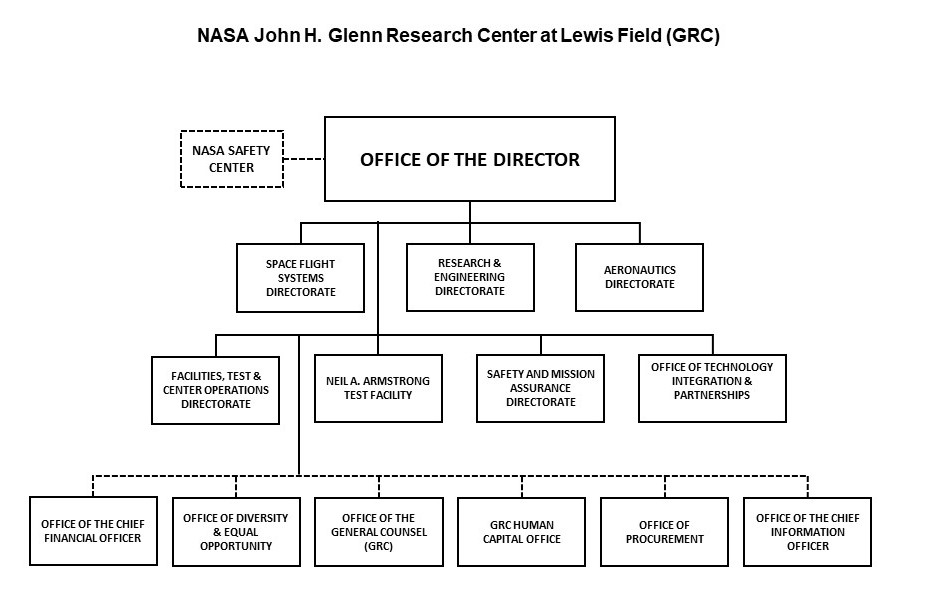
5.5.1 EMPHASIS. The Goddard Space Flight Center (GSFC), as a science Center, seeks to understand the Earth and to explore the universe through a robust program of scientific research in Earth science, astrophysics, heliophysics, and planetary science. As a spaceflight Center, GSFC utilizes its core technical and programmatic expertise and facility capabilities to execute a broad range of flight missions and field campaigns. GSFC is committed to enabling innovation and developing new technologies that expand the Agency's technical capabilities in support of its overarching mission.
5.5.2 GSFC SPECIFIC RESPONSIBILITIES.
Specifically, the Center Director:
a. Implements responsibilities as stated in 5.1, Roles and Responsibilities Common to Center Directors.
b. Executes technical and programmatic Center Roles as designated in Section 6.2.
5.5.3 SPECIAL RELATIONSHIPS.
Manages the following component facilities and/or Technical and Support Service Centers: Wallops Flight Facility (WFF/Wallops); Katherine Johnson Independent Verification and Validation Facility (IV&V); Goddard Institute for Space Studies (GISS; and NASA Space Network at White Sands).
a. WFF/Wallops is NASA's principal facility for management and implementation of suborbital research programs and serves as a test site for new launch technologies.
b. The IV&V facility hosts and manages the Agency-level IV&V function which applies system and software engineering best practices to evaluate the correctness and quality of critical and complex software systems throughout the Systems Development Life Cycle.
c. The GISS is a component laboratory of GSFC's Earth Sciences Division. GISS specializes in space-based observations, provides a critical perspective for monitoring global climate and developing an understanding of Earth systems.
d. The Space Network at the White Sands complex hosts antenna dishes that are part of NASA's ground-based communication systems to orbiting spacecraft.
5.5.4 IMMEDIATE LINE OF SUCCESSION. In the following order: Deputy Director; Associate Director; and Director, Management Operations.
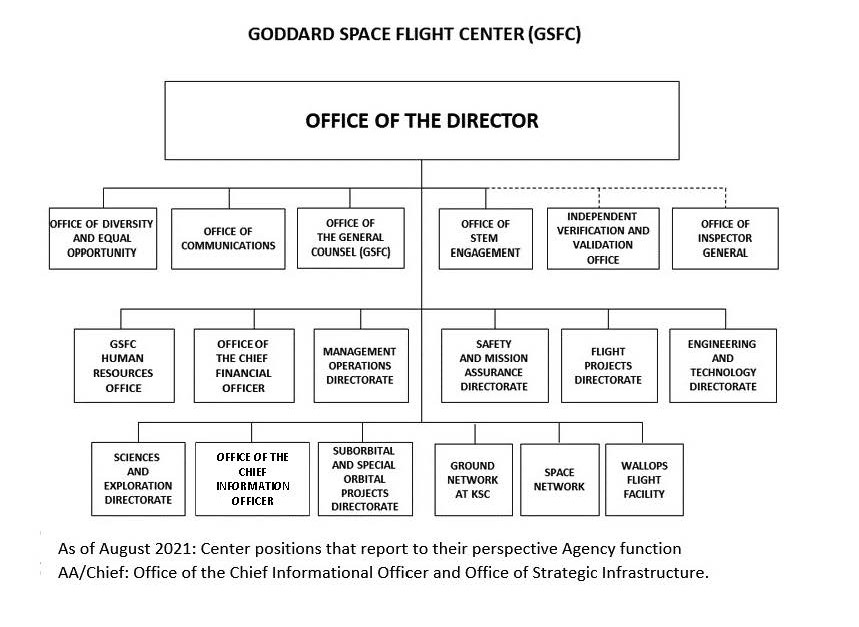
5.6.1 EMPHASIS. The Johnson Space Center (JSC) leads NASA's human space exploration, with an emphasis on operating low-Earth orbit platforms, enabling command access to space crew support, and developing deep space missions. The JSC core functions include design, development, test, and evaluation of human spacecraft; plan, train for, and fly human space missions; maintain human health and performance in space; and manage large, complex programs, all of which require a comprehensive understanding of space and planetary environments. JSC most notably hosts the astronaut corps, as well as enables international and commercial partnerships related to human spaceflight.
5.6.2 JSC SPECIFIC RESPONSIBILITIES.
Specifically, the Center Director:
a. Implements responsibilities as stated in 5.1, Roles and Responsibilities Common to Center Directors.
b. Executes technical and programmatic Center Roles as designated in Section 6.2.
5.6.3 SPECIAL RELATIONSHIPS.
Manages the following component facility: White Sands Test Facility (WSTF).
The WSTF is a unique resource for testing and evaluating hazardous materials, space flight components, and in-space rocket propulsion systems. Located near Las Cruces, New Mexico, WSTF was established in 1963 on the White Sands Missile Range.
5.6.4 IMMEDIATE LINE OF SUCCESSION. In the following order: Deputy Director; Associate Director; Director of Flight Operations; and Director of Engineering.
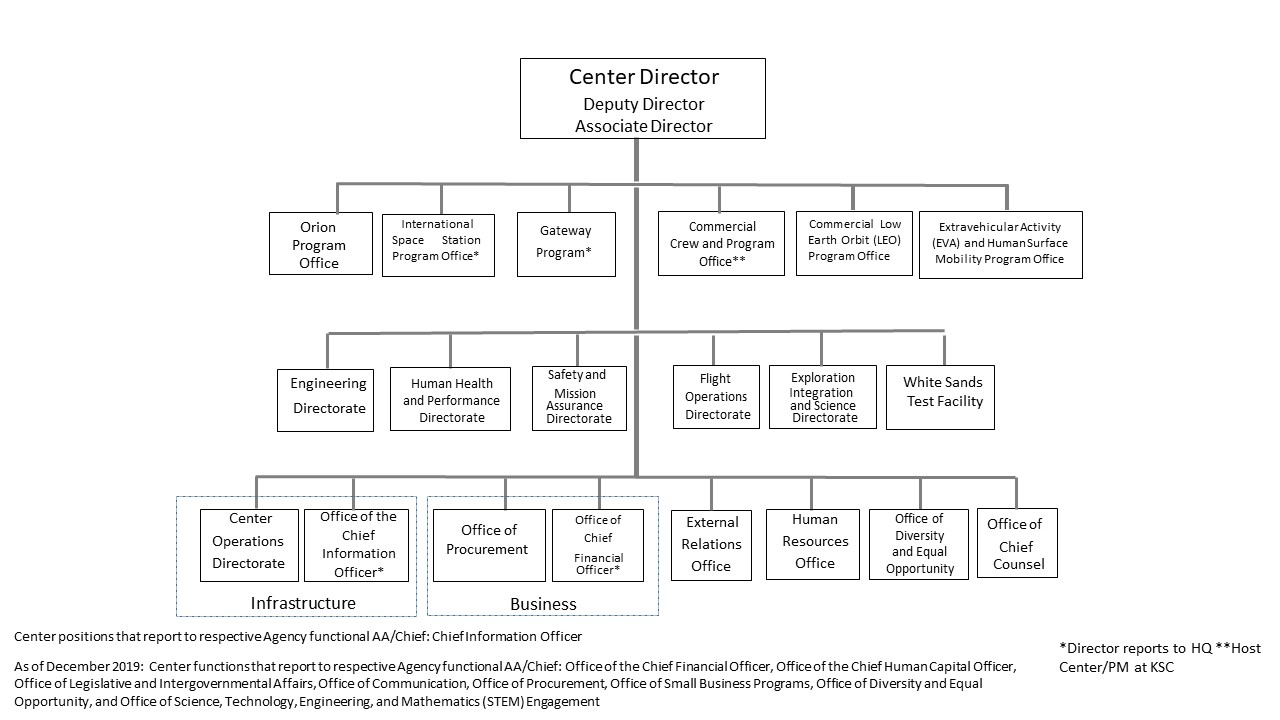
5.7.1 EMPHASIS. The Kennedy Space Center (KSC) is responsible for the preflight processing, launch, landing, and recovery of the Agency's human-rated spacecraft and launch vehicles; the assembly, integration, and processing of International Space Station (ISS) elements and flight experiments; the acquisition and management of Launch Services for Agency spacecraft; and leading the development of a commercial crew transportation system for access to and from low-Earth orbit. KSC leads the development of ground systems supporting human-rated spacecraft and launch vehicles. 5.7.2 KSC SPECIFIC RESPONSIBILITIES.
Specifically, the Center Director:
a. Implements responsibilities as stated in 5.1, Roles and Responsibilities Common to Center Directors.
b. Executes technical and programmatic Center Roles as designated in Section 6.2.
5.7.3 SPECIAL RELATIONSHIPS.
a. Shares a boundary with the Merritt Island National Wildlife Refuge that includes 140,000 acres of land, water, and marshes.
b. Maintains a Government-owned launch site as a multiuser spaceport supporting Government and commercial providers. KSC facilities that are available for use by commercial and other Government space-related organizations include: Pad-A (former Shuttle Launch Pad 39A), the Shuttle Landing Facility (SLF), the three Orbiter Processing Facility (OPF) high bays, a high bay in the Vehicle Assembly Building (VAB), and several other smaller facilities and labs.
5.7.4 IMMEDIATE LINE OF SUCCESSION. In the following order: Deputy Director; Associate Director; and Director of Spaceport Integration and Services.
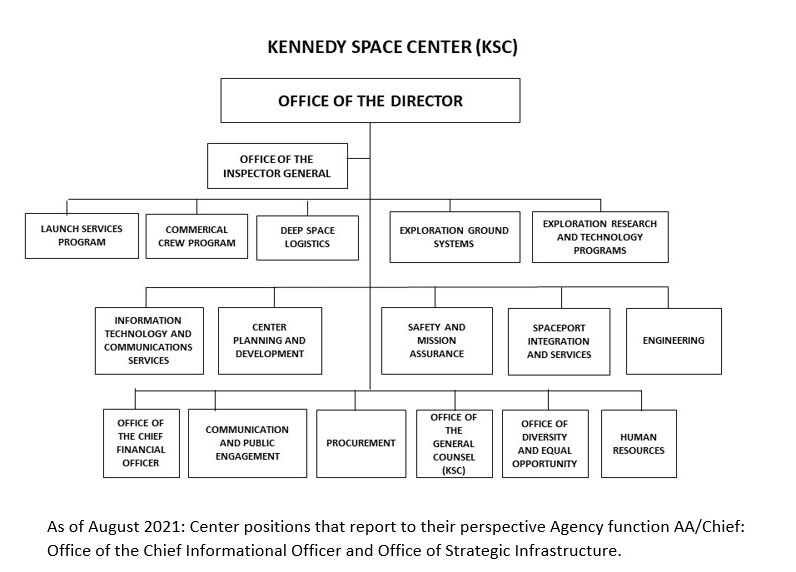
5.8.1 EMPHASIS. The Langley Research Center (LaRC) is recognized as a leader in systems innovation for expanding air mobility, exploring space, and characterizing the Earth's changing climate. LaRC's work spans fundamental research to mission development and operations with a focus on the next generation of cutting-edge capabilities and improvements in performance and cost. LaRC's on-site facilities enable space exploration, aeronautics, and science to conduct experimentation, testing, and validation from concept to flight needed to advance aerospace technologies.
5.8.2 LaRC SPECIFIC RESPONSIBILITIES.
Specifically, the Center Director:
a. Implements responsibilities as stated in 5.1, Roles and Responsibilities Common to Center Directors.
b. Executes technical and programmatic
Center Roles as designated in Section 6.2.
5.8.3 SPECIAL RELATIONSHIPS.
Hosts the NASA Engineering and Safety Center (NESC) which performs independent testing, analysis, and assessments of NASA's high-risk projects to ensure safety and mission success.
5.8.4 IMMEDIATE LINE OF SUCCESSION. In the following order: Deputy Director; Associate Director; and Director for Research.
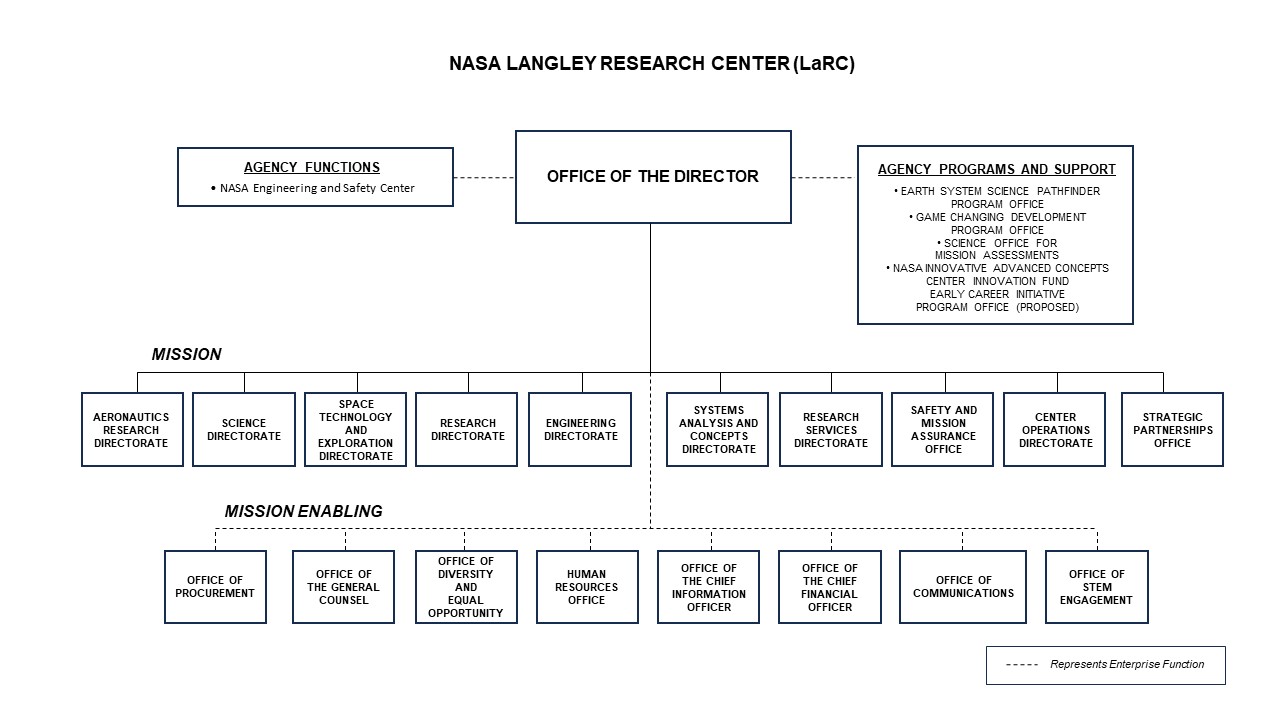
5.9.1 EMPHASIS. The Marshall Space Flight Center (MSFC) provides leadership in the complex engineering of space transportation and propulsion systems, large space structures and systems, and scientific research for human space exploration. MSFC is responsible for NASA's launch vehicle development. MSFC also enables scientific discovery through development and testing of hardware and instruments for a variety of projects in high-energy astrophysics, heliophysics, and applied Earth science.
5.9.2 MSFC SPECIFIC RESPONSIBILITIES.
Specifically, the Center Director:
a. Implements responsibilities as stated in 5.1, Roles and Responsibilities Common to Center Directors.
b. Executes technical and programmatic Center Roles as designated in Section 6.2.
5.9.3 SPECIAL RELATIONSHIPS.
a. Supports the following external relationships: Co-located with several Department of Defense agencies on Redstone Arsenal, adjacent to Cummings Research Park, the second largest research park in the Nation.
b. Manages the following component facility: Michoud Assembly Facility (MAF).
The MAF is a unique manufacturing and assembly facility that meets the needs of NASA's human space exploration programs.
c. Manages the contractual interface with the Applied Physics Lab (APL) for all NASA procured work at APL.
5.9.4 IMMEDIATE LINE OF SUCCESSION. In the following order: Deputy Director; Associate Director; and Associate Director, Technical.
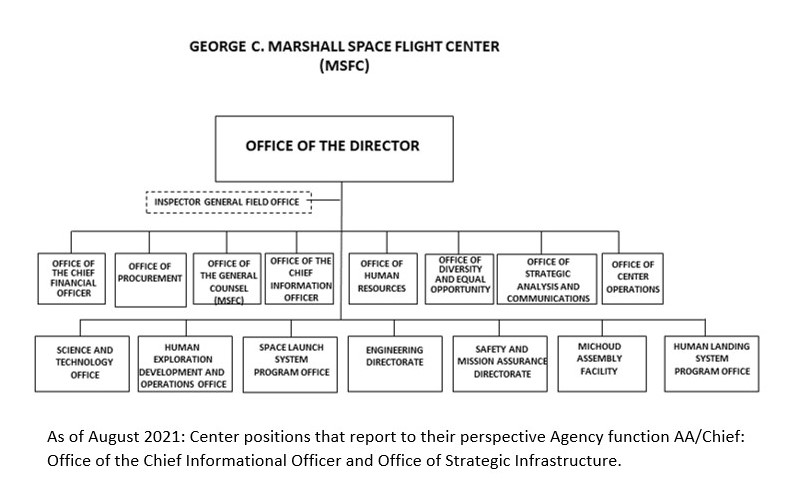
5.10.1 EMPHASIS. The Stennis Space Center (SSC) manages and operates rocket propulsion test facilities and provides propulsion test services for NASA, the Department of Defense, and commercial customers.
5.10.2 SSC SPECIFIC RESPONSIBILITIES.
Specifically, the Center Director:
a. Implements responsibilities as stated in 5.1, Roles and Responsibilities Common to Center Directors.
b. Executes technical and programmatic Center Roles as designated in Section 6.2.
5.10.3 SPECIAL RELATIONSHIPS.
a. Hosts the NASA Shared Services Center (NSSC) which performs integrated administrative functions and transactional activities for NASA in the areas of human resources, information technology, finance, and procurement.
b. As a "Federal City," hosts over 60 Federal, state, academic, and commercial interests, many of them engaged in technology-based initiatives. The resultant marine science technology cluster is an economic driver for the region, supporting Federal, state, and commercial interests. Institutional operational costs are shared among resident agencies.
c. Hosts to several universities such as Mississippi State University and the University of Southern Mississippi which offer a range of doctoral programs in engineering and marine science disciplines, respectively.
5.10.3 IMMEDIATE LINE OF SUCCESSION. In the following order: Deputy Director; Associate Director; and Director, Engineering and Test Directorate.
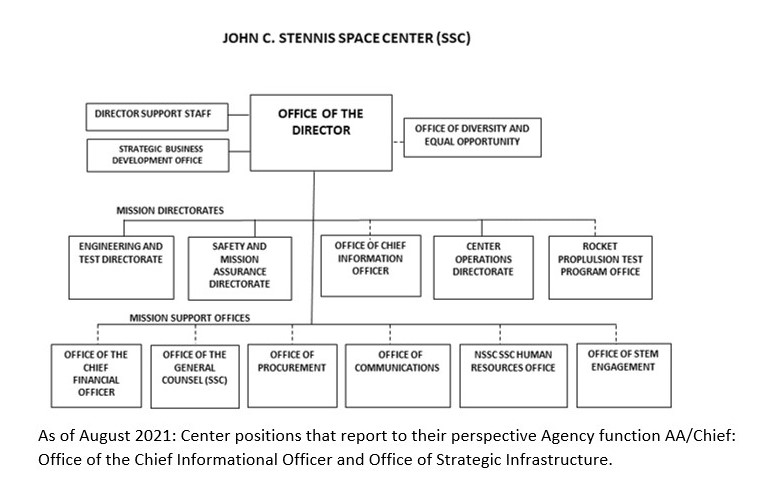
5.11.1 EMPHASIS. The National Aeronautics and Space Administration (NASA) is the sponsor of the Federally Funded Research and Development Center (FFRDC) located in Pasadena, California. NASA Office of JPL Management and Oversight (NOJMO) is the NASA Headquarters (HQ) on-site Government organization serving the functions of contract management, on-site Agency oversight, and ensures regulatory compliance of contractor operations in accordance with 48 CFR 35.017 as an FFRDC.
JPL is funded by NASA to meet specific long-term technical needs that cannot be met by any other single organization within NASA. As part of this special relationship, NASA requires that JPL be operated in the public interest with objectivity and independence, be free from organizational conflicts of interest, and have full disclosure of its affairs to NASA. The contract between NASA and the JPL contractor is the sponsoring agreement for the FFRDC.
5.11.2 NOJMO DIRECTOR OVERALL RESPONSIBILITIES.
The NASA Office of JPL Management and Oversight (NOJMO) Director reports to the NASA Associate Administrator and serves as the Official-in-Charge managing the sponsoring agreement with the contractor operating the FFRDC at Pasadena, referred to as JPL. The roles and responsibilities of the contractor are described in the sponsoring agreement (The Prime Contract) for Laboratory operation and management and the NOJMO Director provides on-site oversight of their implementation while ensuring that the statutory, regulatory, and fiduciary compliance requirements are met.
The NOJMO Director also performs key activities in support of NASA missions, including acquisition strategy development and implementation, execution, and management of the JPL sponsoring agreement, requirements definition and planning, contract negotiation and award, post-award contract administration, and contract oversight. As the Head of Contracting Activity (HCA), the NMO Director has ultimate responsibility for ensuring that contract management systems, awards, and administration of the prime contract with the FFRDC contractor are in accordance with laws, regulations, and NASA policies.
As the primary interface to the NASA Associate Administrator, the NOJMO Director implements strategic and tactical directives from NASA HQ. The NOJMO Director is responsible for coordinating and communicating any issues to Mission Directorate Associate Administrators and other senior leaders, as appropriate.
NASA assigns certain authorities and programmatic roles to the JPL contractor, via the sponsoring agreement, to support the NASA Mission Directorates. The NOJMO Director is responsible for ensuring that the JPL contractor implements Technical Authority in compliance with applicable NASA policies and contractual requirements of the sponsoring agreement.
The NOJMO Director serves an important role in the operational activities of JPL. Specifically, the NOJMO Director:
a. Serves as the focal point for communication with the JPL contractor's upper management and the leadership at the contractor parent organization.
b. Serves as the direct interface for policy between the JPL contractor's management and the Associate Administrator and the management of the Mission Directorates and their organization's sponsoring activities at JPL.
c. Establishes interfaces between the Directorates and the JPL contractor to ensure the successful execution of operational functions associated with the management of JPL, including operations at the overseas Deep Space Network facilities in Australia and Spain.
d. Ensures compliance of NASA assets at JPL with applicable safety and health policies and regulations.
e. Serves as management coordinator and point of contact between JPL, HQ, and other NASA entities with respect to environmental, health, safety, mission assurance, emergency preparedness, continuity of operations, and facilities maintenance and provides advocacy and concurrence on Construction of Facilities (CoF) related activities.
f. Actively represents NASA in outreach and educational events.
g. Provides technical and institutional resources as authorized to satisfy Agency requirements and schedules.
h. Maintains a safe and healthy workplace environment for the NOJMO workforce and ensures safety for all NOJMO activities.
i. Per NPD 8700.1, NASA Policy for Safety and Mission Success, the NOJMO Director also has full authority to stop any unsafe activity occurring at JPL.
j. Assures that risks to the public and environment associated with the operation of JPL are acceptable to NASA.
k. Provides asset management oversight function consisting of Logistics, Transportation, Real Property Industrial Property, and Property Disposal functions at JPL, as appropriate.
l. Provides Agency implementation oversight functions for Freedom of Information Act (FOIA), Records Management, and Privacy Act at JPL.
m. Provides Agency implementation oversight functions for the Innovative Research, Technology Transfer, Small Business, and Export Control compliance at JPL.
n. Oversees the NASA environmental restoration CERCLA project which interacts programmatically with the NASA HQ Environmental Management Division.
o. Supervises a Chief Counsel's Office in its delivery of legal advice and services to the NOJMO, including those related to: all legal aspects of the administration of NASA's contract with the JPL contractor, proper implementation of fiscal law, environmental law, employment law, ethics, real and industrial property, occupational safety, export control, litigation, FOIA, and related policies. The NOJMO Chief Counsel's Office also provides specialized legal advice on the JPL's new technology and invention reporting, Space Act Agreements, Economy Act Transactions, and innovative partnerships. The NOJMO Patent Counsel is the point of contact for legal issues pertaining to protecting NASA's intellectual property as it relates to JPL.
p. Oversees the FFRDC's Security Program to ensure the implementation of NASA policies and procedures to protect employees, property, and information. In concurrence with the Associate Administrator and the AA for Mission Support, determines the appropriate staffing complement for NOJMO.
q. The NOJMO Director serves as a member of Agency Governance Councils as defined in Chapter 3 of this NPD.
5.11.3 SPECIAL RELATIONSHIPS.
The NOJMO manages the contract associated with the operation of the NASA component facility, Deep Space Network Communication Complexes, with the governments of Spain and Australia and other contracts as assigned by the Associate Administrator.
5.11.4 IMMEDIATE LINE OF SUCCESSION. In the following order: NOJMO Deputy Director, Procurement Officer, and Division Chief, Program Oversight and Institutional Management.
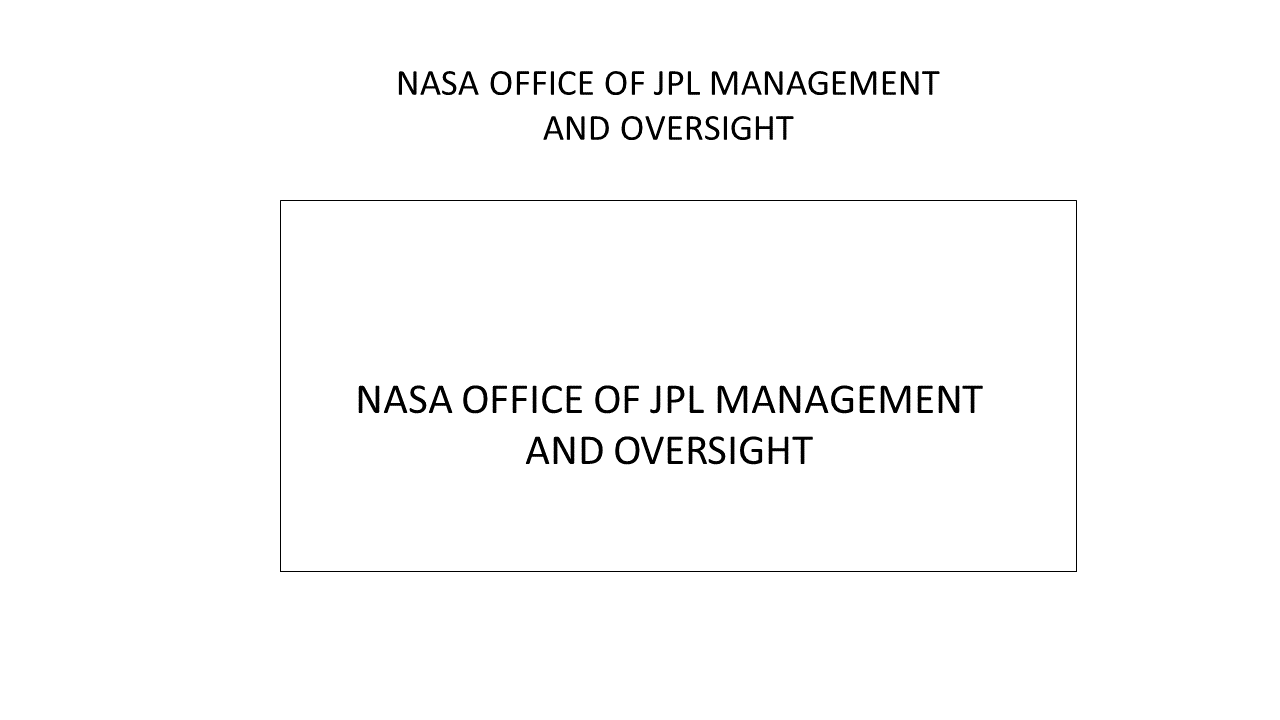
5.12.1 EMPHASIS: The Jet Propulsion Laboratory (JPL) is a lead organization for robotic science missions conducted in space and performs the core competency areas assigned to JPL. As a Federally Funded Research and Development Center (FFRDC), JPL meets the special, long-term research and development needs of NASA missions that cannot be met as effectively by existing in-house Federal or contractor resources. JPL successfully accomplishes directed or competed missions through program planning, concept engineering, trades, and analysis; development of enabling technologies; mission, system, and instrument design, analysis, development, fabrication, assembly, test and operations; and science data analysis.
5.12.2 NASA'S FFRDC LABORATORY DIRECTOR RESPONSIBILITIES.
a. NASA's FFRDC Laboratory Director, hereby referred to as the Lab Director, is a senior executive officer of the contractor organization and is neither a civil servant nor an agent of the Government. The Lab Director is the contractor's authorized representative responsible for day-to-day operations and management of JPL and contract compliance; therefore, responsible for identifying, allocating, and dispersing resources, including overseeing the assignment of the contractor workforce and facilities, and managing the JPL's assigned operations to facilitate program and project execution. Specific NASA mission activities are assigned to and performed by the JPL contractor in accordance with the contract and various discrete task orders administered by the NOJMO.
b. Consistent with Federal Acquisition Regulation 35.017, the JPL contractor may be allowed access to Government and supplier data, including sensitive and proprietary data, and to NASA employees and facilities beyond that which is common to the normal contractual relationship. Additional details may be found in NPI 1000.99.
c. The Lab Director provides technical and institutional resources to satisfy program requirements and schedules to include engineering, safety, and mission assurance and ensures that human, financial, information technology, physical, and other supporting resources are properly applied to programs. Maintains a safe and healthy, environmentally friendly work environment for the contractor workforce and ensures safety, security, reliability, and quality assurance for all JPL activities.
5.12.2.1 The key programmatic role of the Lab Director is that of service across Mission Directorate needs, determining how best to balance and execute the various programs and projects hosted at JPL in accordance with Agency priorities and communicates any program- or project-related issues to Mission Directorate Associate Administrators and other NASA senior leaders, including the NOJMO. Specifically, the Lab Director:
a. Ensures regular review and reporting of performance for assigned programs and projects.
b. Provides input for the Agency's Program Management Council reviews and Baseline Performance Reviews on programs and projects assigned to the FFRDC.
c. Provides resources to satisfy program requirements and schedules, to include project management, engineering, and safety and mission assurance. Ensures that human, financial, physical, and other supporting resources are properly applied to programs under their authority.
d. Responsible for implementing missions contractually assigned to JPL, including achieving mission success and ensuring the safety and security of personnel and institutional assets.
e. Responsible for the care of institutional assets assigned to JPL and for establishing and maintaining the staff and their competency and the facilities required by current and future programs and projects, in accordance with accepted standards and applicable NASA requirements.
f. The Lab Director may be invited to NASA's governance councils and boards, subject to NPI 1000.99 and Chapter 6, paragraph 6.4 of this NPD.
5.12.2.2 The Lab Director is accountable for exercising Technical Authority at JPL, including the reclama process, upon delegation by NASA through the prime contract. The Lab Director facilitates the activities of the Technical Authorities and is responsible for ensuring that activities at JPL are implemented in accordance with accepted standards and applicable NASA policies. Specifically, as delegated by NASA and within constraints specified in the prime contract, the role requires that the Lab Director:
a. Exercise Technical Authority through appropriate institutional delegation.
b. Exercise definitive decision authority as delegated to resolve issues on such matters as technical requirements tailoring, waivers, and deviations to requirements.
c. Convene an independent review at major milestones to ascertain technical readiness on assigned programs and projects.
d. Certify to NASA the readiness of projects, systems, and services for which authority has been delegated.
e. Approve the flight readiness of projects for which Technical Authority has been delegated.
f. Coordinate with the NASA functional offices and NOJMO to ensure organizational and financial independence of the Technical Authorities and implement the Formal Dissent Process as required in NPD 1000.0, NASA Governance and Strategic Management Handbook, and described further in NPR 7120.5.
5.12.2.3 The Lab Director serves an important role in the day-to-day operations management of the Lab and is responsible for providing assets, staffing, and facilities required by current and future programs and projects. Specifically, the Lab Director:
a. Implements plans that address the strategic goals and outcomes in the NASA Strategic Plan, Agency performance goals, and related governance decisions.
b. Provides input for Agency Program Management Council reviews and Baseline Performance Reviews as requested by NASA.
c. Collaborates with NASA Centers per Center Role assignments to accomplish the Agency's objectives.
d. Exercises responsive local decision-making authority to address urgent local execution issues.
e. Per NPD 8700.1, NASA Policy for Safety and Mission Success, the Lab Director also has full authority to stop any unsafe activity; programmatic or otherwise, if it involves JPL contractor personnel or NASA facilities or assets.
f. Operates JPL in the public interest with objectivity and independence, free from organizational conflict of interest, and with full disclosure of its affairs to NASA.
g. Coordinates and communicates with NASA Headquarters, JPL's implementation and outreach activities, stakeholder management, and partnerships on a regular basis.
h. Represents JPL in promoting and maintaining good public and community relations and providing for the widest practical and appropriate dissemination of information concerning space activities. Conducts educational and public outreach as coordinated with the Office of Communications at NASA Headquarters prior to the award of a contract or the expenditure of funds to ensure Agency-wide priorities and consistent communications.
i. Supports the Agency CFO regarding JPL contractors' financial performance.
j. Develop overall and integrated capability strategy for the lab including facility master planning and strategic workforce plans for consideration by NASA leadership.
5.12.2.4 The Lab Director performs specific responsibilities assigned to the FFRDC. Specifically, the Lab Director executes delegated technical and programmatic Center Roles as designated.
5.12.3 SPECIAL RELATIONSHIPS.
JPL manages the operation of the component facility, Deep Space Communications Network, for NASA providing uplink and downlink communication for NASA's deep space missions.
5.12.4 IMMEDIATE LINE OF SUCCESSION. The line of succession for the JPL contractor is not discussed here as the contractor staff members are not Government employees and hence not part of NASA's institutional governance process.
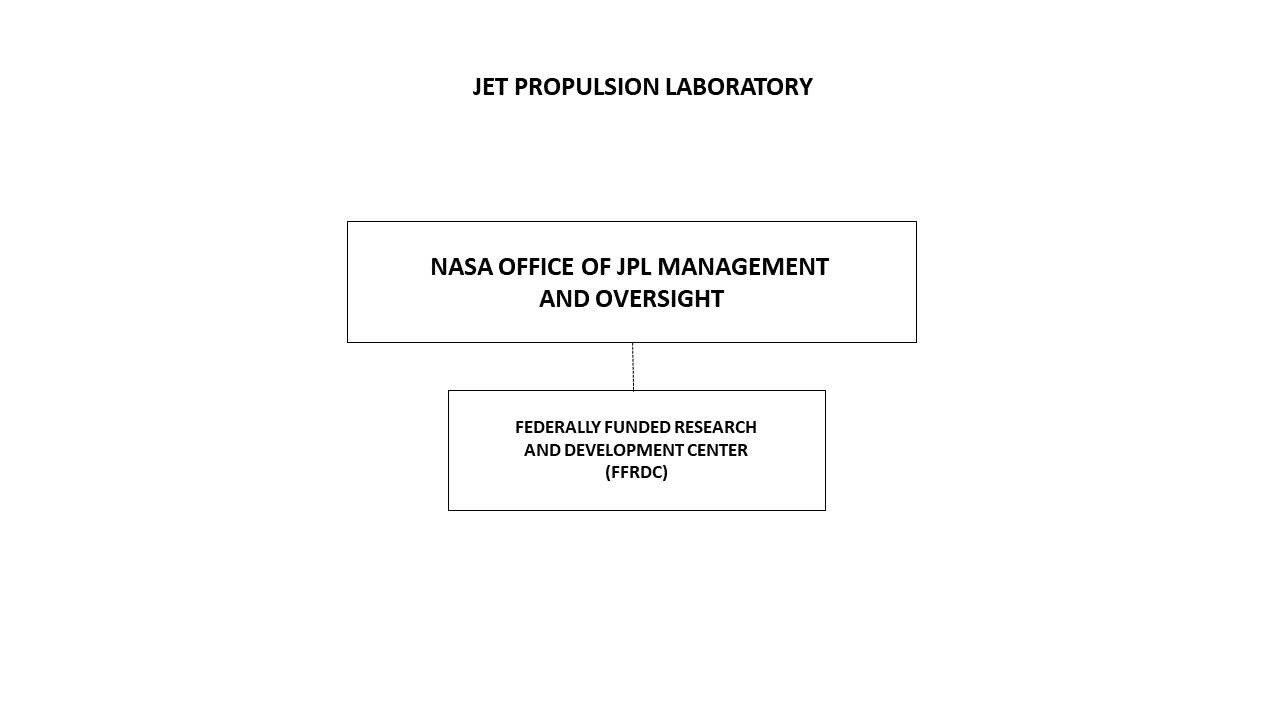
5.13.1 MISSION. The NASA Engineering and Safety Center (NESC), located at the Langley Research Center, serves as a major Agency-wide technical resource focused on engineering excellence supporting the safety and success of NASA's missions. NESC provides independent engineering and technical expertise to evaluate technical problems and supplement Center-based engineering and safety activities for NASA's programs. NESC shall perform independent engineering assessments, analysis, and testing to ensure technical adequacy and, thus, the safety of NASA's activities. In relation to the Center's mission, the term "safety" encompasses those aspects of NASA's system designs and operations that are important to mission success and that relate to potential risks to the public, to NASA, and to contractor flight and ground personnel. The term "engineering" signifies any of the professional technical design, manufacturing, and operational disciplines, including systems engineering and the various assurance engineering disciplines. NESC serves the engineering, safety and mission assurance, and program/project communities as a value-added, independent resource.
5.13.2 OVERALL RESPONSIBILITIES. The NESC Director reports to the NASA Chief Engineer and performs the following activities:
5.13.2.1 Resolves high-risk technical issues by performing independent, in-depth technical assessments, testing, and analyses for NASA programs, projects, engineering and technical organizations, and Safety and Mission Assurance (SMA) organizations.
5.13.2.2 Proactively identifies potential technical issues by maintaining technical insight to major programs and performs independent data-mining and trend-analysis activities within single NASA programs and across multiple NASA programs.
5.13.2.3 Provides Agency-level stewardship for critical engineering disciplines and performs discipline-enhancing activities through the NASA Technical Fellows Program.
5.13.2.4 Transfers knowledge and lessons learned through various technical reports, communications, and the NESC Academy.
5.13.2.5 Provides independent systems engineering and analysis.
5.13.2.6 Leads and supports selected mishap investigations, as requested by the NASA Safety Center (NSC) and other organizations.
5.13.3 SPECIAL RELATIONSHIPS. The core NESC organization is comprised of senior engineering experts from across the Agency, whose capabilities are complemented through partnerships with additional experts within NASA, other Government organizations, national laboratories, universities, and industry. NASA Centers provide technical personnel, resources, and facilities to support the NESC mission. NESC partners with the NASA Safety Center (NSC) in the conduct of selected technical assessments, mishap investigations, and other activities. The NSC provides SMA discipline expertise for NESC-led teams. NESC provides engineering discipline expertise for NSC-led teams, as requested.
5.13.4 LINE OF SUCCESSION. Deputy Director, NASA Engineering and Safety Center; and Deputy Director for Safety, NASA Engineering and Safety Center.
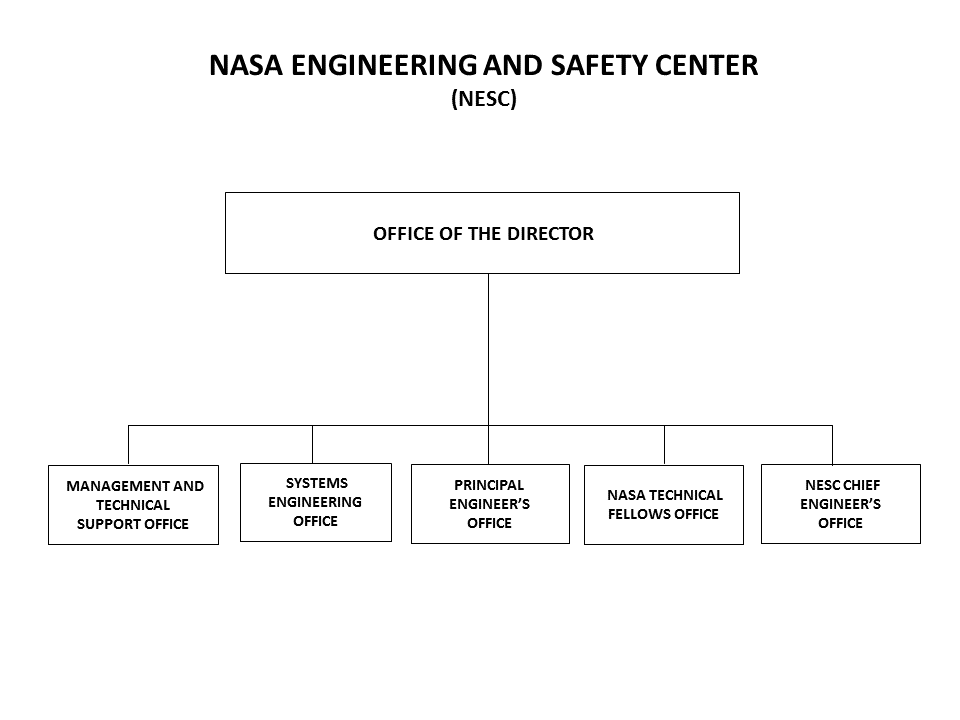
5.14.1 MISSION. The NASA Shared Services Center (NSSC), located at Stennis Space Center, serves as a major Agency-wide service resource that provides timely, accurate, high-quality, cost-effective, and customer-focused services for NASA. The NSSC serves the information technology (IT), financial management, procurement, and human resources communities as a value-added, independent resource. Increased operational efficiency and improved overall customer service are achieved through consolidated business and technical services. By achieving synergy within and across functions, the NSSC will reduce resource requirements for institutional support areas and position NASA for further business process improvements and innovations.
5.14.2 OVERALL RESPONSIBILITIES. The NSSC Executive Director reports directly to the Associate Administrator for Mission Support.
5.14.2.1 Specifically, the Executive Director for the NSSC:
a. Provides timely, accurate, high-quality, cost-effective, and customer-focused support for selected NASA businesses and technical services.
b. Provides a variety of transactional, administrative, and technical activities in lines of business to include: Financial Management, Human Resources, Procurement, Enterprise IT, and Agency Business Support.
c. Provides management of resources responsible for the budget formulation, execution, and accounting operations of the NASA Working Capital Fund in Support of NSSC operations and Agency programs.
d. Provides effective and consistent services for all employees and vendors by standardizing business processes and integrating systems and technology.
e. Implements an organization that employs shared services leading practices in management and process development.
f. Promotes the Agency's strategic goals with the common purpose of achieving NASA's vision and mission by providing support Agency wide.
5.14.3 SPECIAL RELATIONSHIPS. The NSSC Executive Director:
a. Serves as a member of NASA's Agency Governance Coulcils as defined in Chapter 3 of this NPD.
b. Shares an infrastructure alliance with the Stennis Space Center.
c. Works in cooperation with the following officials to provide services at the NSSC:
(1) Chief Financial Officer to provide management of financial management services.
(2) Chief Human Capital Officer to provide management of human resources services.
(3) Chief Information Officer to provide enterprise IT services and management of the NSSC IT environment.
(4) Assistant Administrator for Procurement to provide management of procurement services.
5.14.4 LINE OF SUCCESSION. In the following order: Director, Service Delivery Directorate, NSSC; and Director, Support Operations Directorate, NSSC.
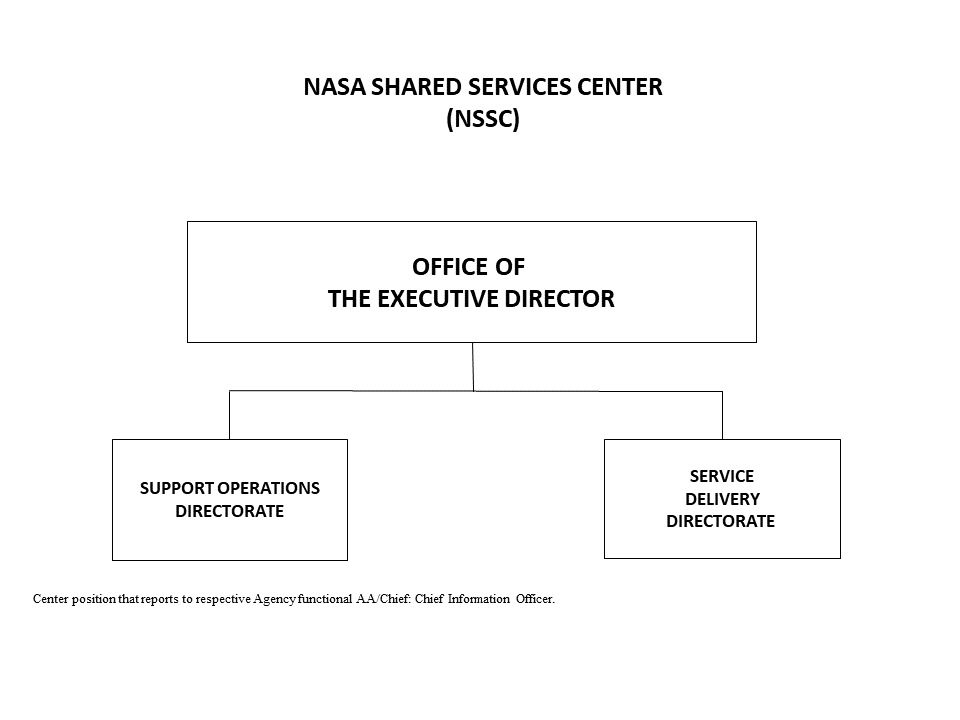
5.15.1 MISSION. The NASA Safety Center (NSC), a tenant organization located near and administratively supported by the Glenn Research Center, serves as an Agency-wide resource for strengthening Safety and Mission Assurance (SMA) capabilities and enabling more uniform and effective SMA support for the safe and successful execution of NASA programs. The NSC promotes technical excellence through a balanced program for leadership development, education, training, communication, and information management in the SMA disciplines. The term "SMA" refers to the disciplines that include safety, reliability, maintainability, quality engineering, and quality assurance.
5.15.2 OVERALL RESPONSIBILITIES. The Director, NSC, reports to the Chief, Safety and Mission Assurance at NASA Headquarters and manages the NSC in the following activities:
5.15.2.1 Enhances knowledge and capabilities within the SMA community by developing a technical excellence program that fosters education, training, and leadership development within SMA and other engineering disciplines.
5.15.2.2 Provides SMA technical support to Agency managers while embracing the concept that SMA encompasses important engineering and operations disciplines that enable and enhance the effective execution of all NASA programs from concept through retirement or mission completion.
5.15.2.3 Manages the audit, review, and assessment process for evaluating and ensuring conformance with Agency SMA requirements.
5.15.2.4 Facilitates the mishap investigation process and supports mishap investigation boards. Performs in-depth analysis, risk assessment, quality assurance, and trending of NASA's mishaps and provides timely and relevant information to the NASA community to ensure understanding and prevent recurrence as part of NASA's mishap prevention efforts. Manages mishap data and provides a centralized mishap information collection system for the Agency.
5.15.2.5 Captures and disseminates information of importance and usefulness to the SMA community. Maintains a repository and serves as a clearing house for essential data and information collected from the SMA community.
5.15.3 SPECIAL RELATIONSHIPS. NASA Centers provide technical personnel, resources, and facilities to support the NSC mission.
5.15.4 LINE OF SUCCESSION. Deputy Director, NASA Safety Center; Director, Technical Excellence, NASA Safety Center; and Director, Audits and Assessments, NASA Safety Center.
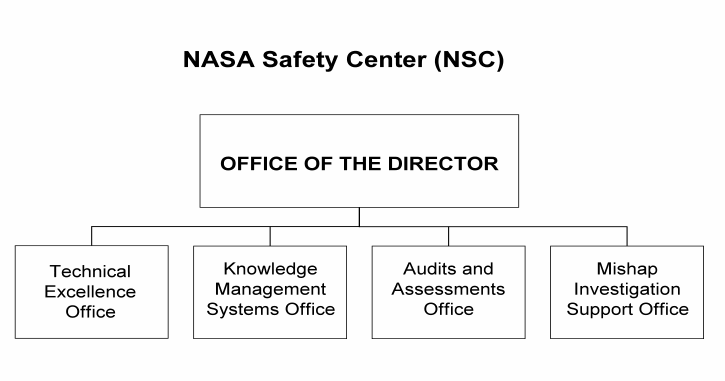
5.16.1 MISSION. The NASA Independent Verification and Validation (IV&V) Program provides assurance to its stakeholders and customers that NASA's mission-critical software will operate dependably and safely. The NASA IV&V Program performs leading-edge research that improves IV&V and software assurance methods, practices, and tools. The NASA IV&V Program participates in the vitality of the community, as well as engages the public in the experience and benefits of exploration and discovery.
5.16.2 OVERALL RESPONSIBILITIES. The Director of the NASA IV&V Program reports to the Chief, Safety and Mission Assurance at NASA Headquarters and manages the following technical activities:
5.16.2.1 Applies software engineering best practices to provide the Agency with an independent assessment of the software correctness and quality on safety and mission-critical software.
5.16.2.2 Provides the early detection and identification of risk elements on safety critical and mission-critical software throughout the System Development Life Cycle.
5.16.2.3 Improves safety, reliability, and quality of NASA projects' and missions' software through effective application of systems and software IV&V methods, practices, and techniques.
5.16.2.4 Provides observations and assessment results to support key decision points and major milestone reviews to the Chief, Safety and Mission Assurance and to NASA project/programs receiving IV&V services.
5.16.2.5 Manages the Agency's Software Assurance Research Program for, and as directed by, the Office of Safety and Mission Assurance.
5.16.2.6 Manages and provides software assurance and software engineering services to the Agency in support of the other Office of Safety and Mission Assurance organizations and provides expert review and input on Agency software related standards, documentation, and processes.
5.16.3 SPECIAL RELATIONSHIPS. Goddard Space Flight Center in Greenbelt, Maryland, provides administrative and facility support in such areas as human capital management, contract management, and facility management, including security and training.
5.16.4 LINE OF SUCCESSION. Deputy Director, NASA IV&V Program; and Associate Director, NASA IV&V Program.
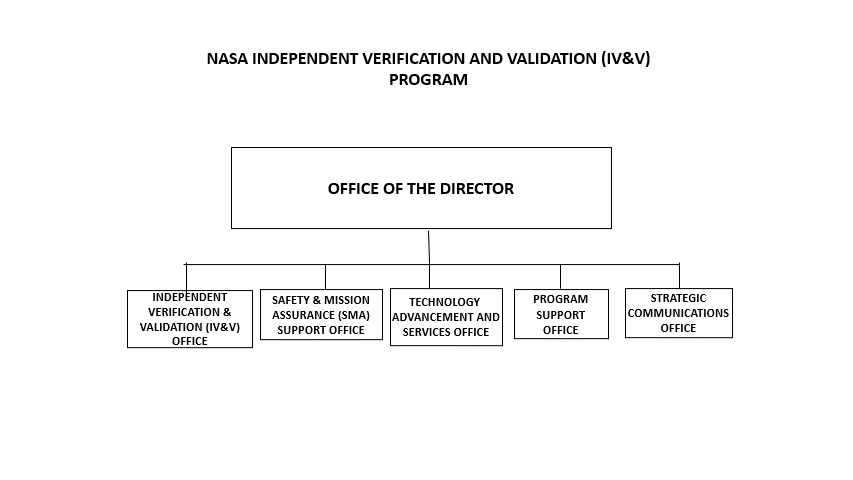
| TOC | ChangeLog | Preface | Chapter1 | Chapter2 | Chapter3 | Chapter4 | Chapter5 | Chapter6 | Chapter7 | ALL | |
| | NODIS Library | Organization and Administration(1000s) | Search | |
This document does not bind the public, except as authorized by law or as incorporated into a contract. This document is uncontrolled when printed. Check the NASA Online Directives Information System (NODIS) Library to verify that this is the correct version before use: https://nodis3.gsfc.nasa.gov.